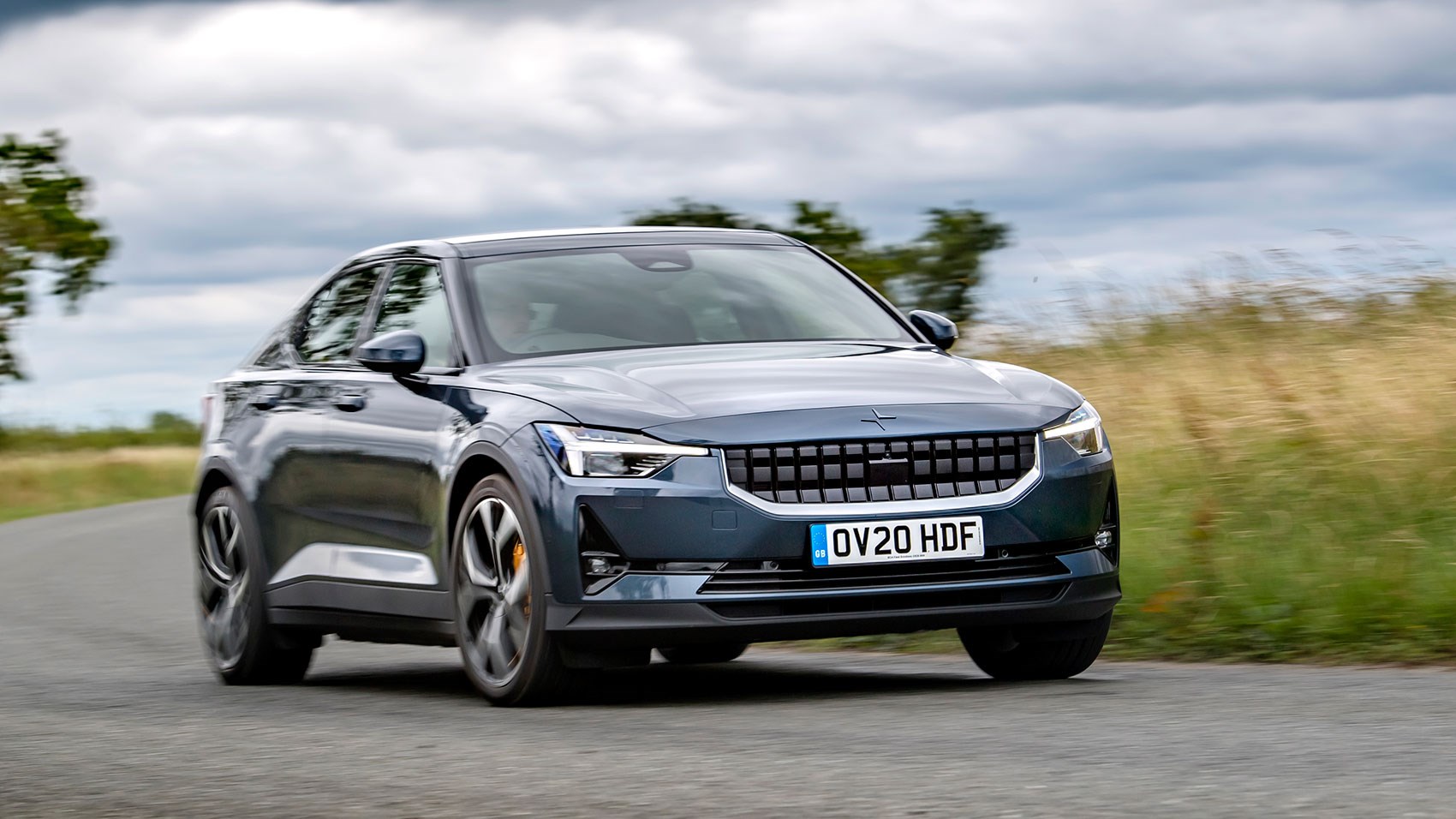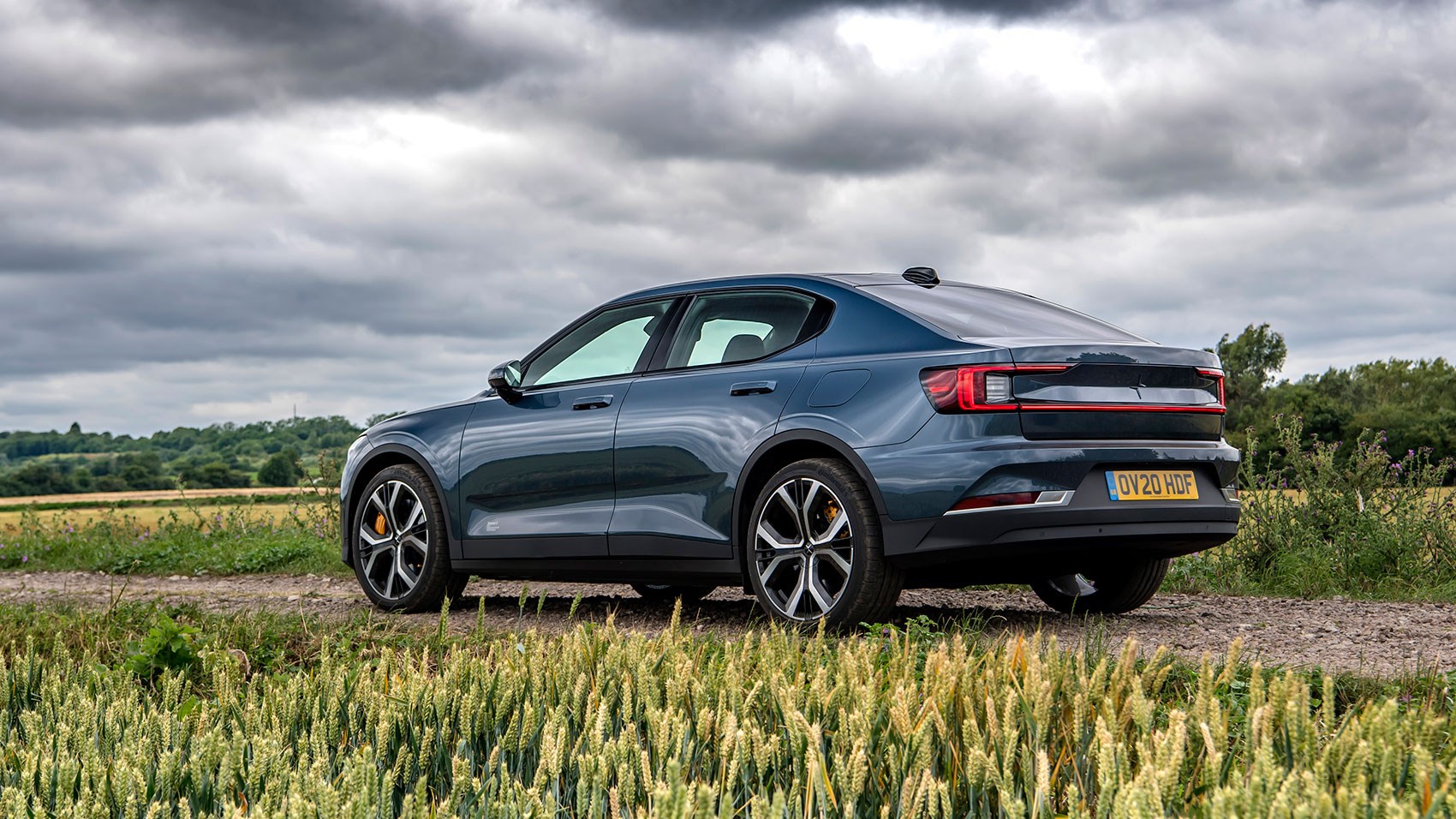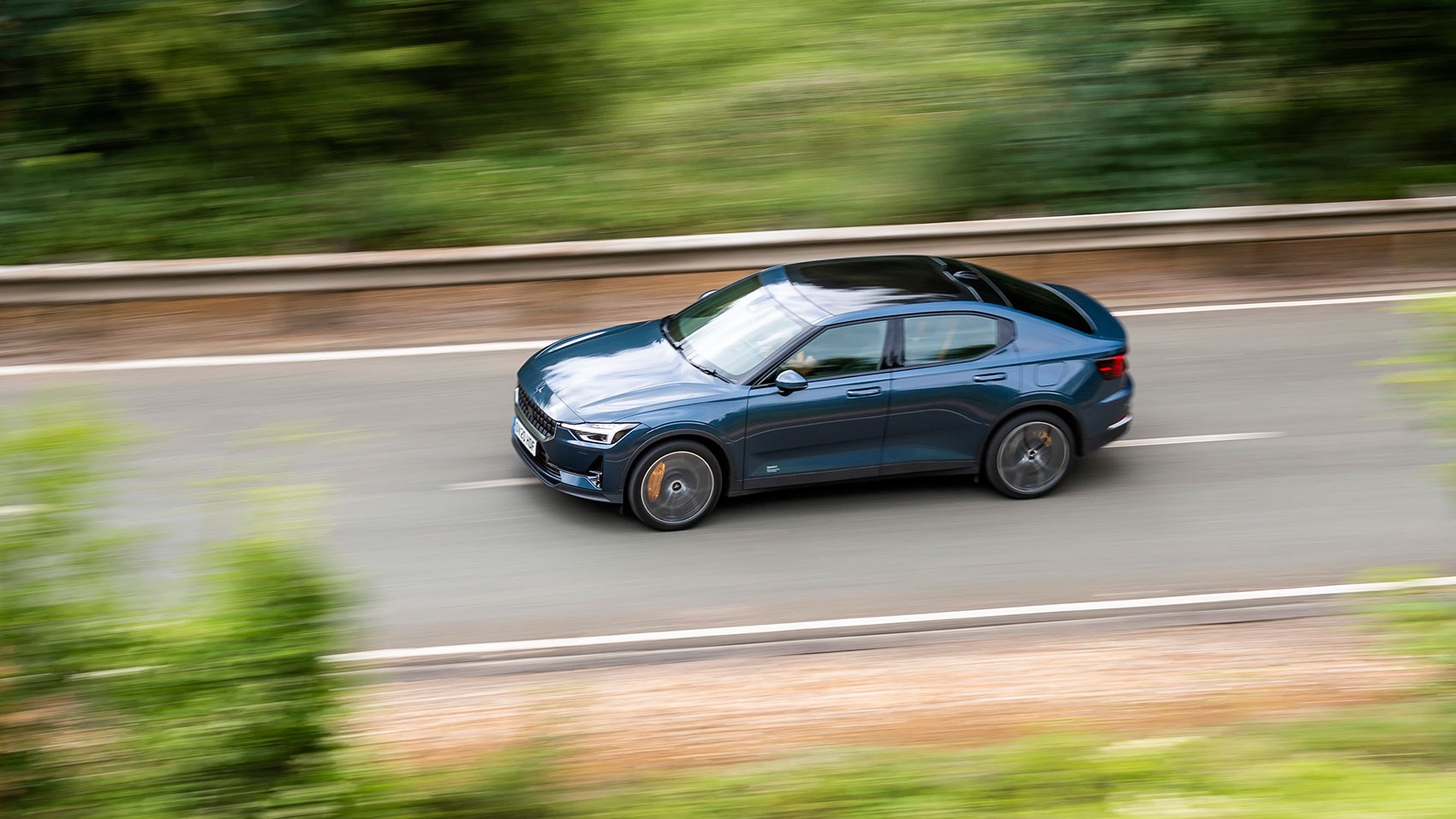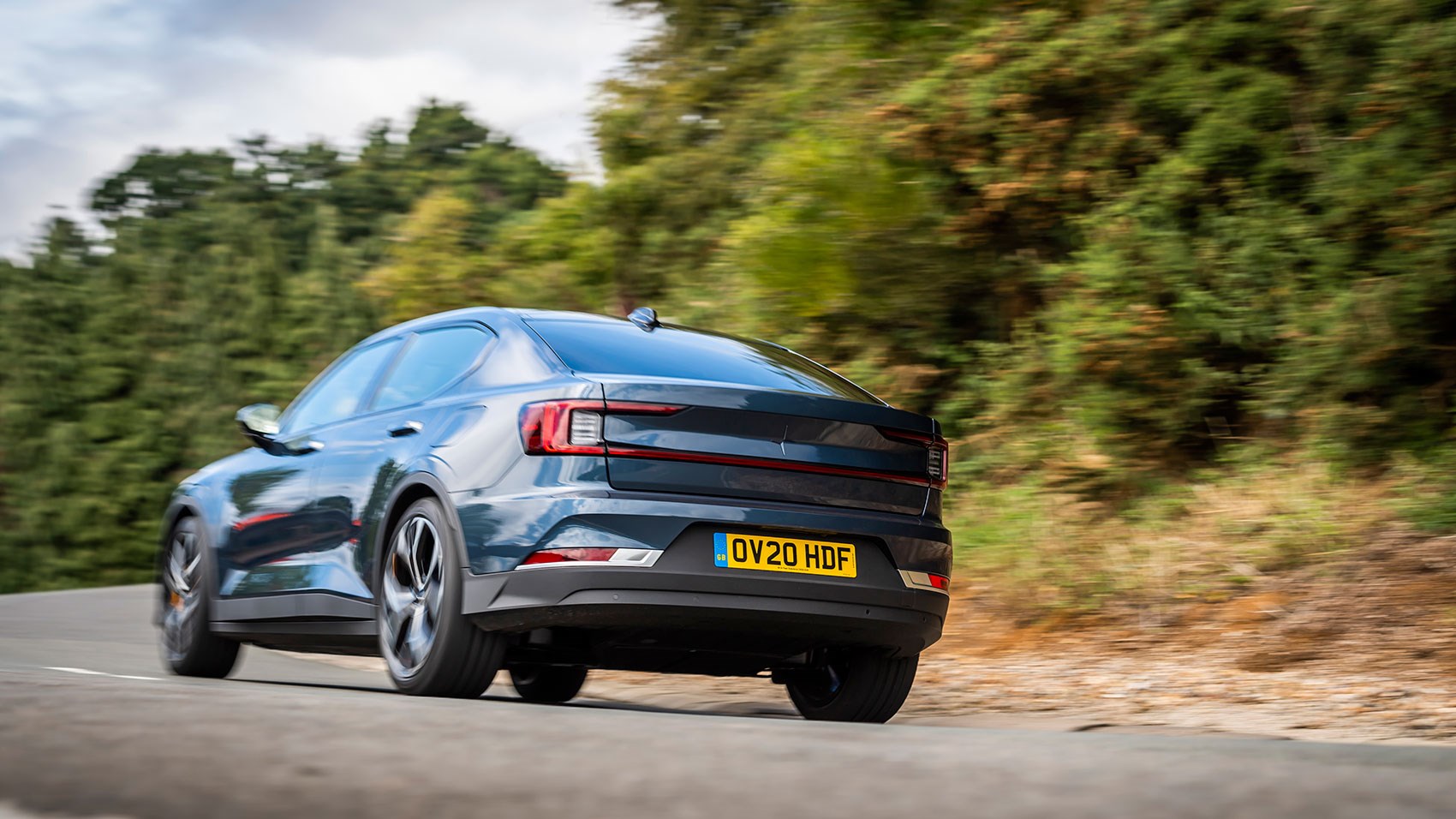► Front and four-wheel drive versions driven
► Range not up to expectations
► Costs from £39,900
Forget the LHD-only hybrid Polestar 1, the Polestar 2 represents the true beginning for Volvo's offshoot. A ground up EV with striking looks and minimalist, Google-powered interior, it's already a rival for the Tesla Model 3, Audi Q4 e-Tron and everything else in the competitive electric SUV/crossover market.
Originally available only in rapid twin motor flavour, the range has expanded to include a front-wheel drive variant. That's available in standard and long range guises with the four-wheel drive's pair of motors exclusively being fed by the higher capacity battery pack.
We've put both single and twin motor versions through their paces on UK roads and, in the case of the latter in Performance guise, on track, too.
The best EVs: our guide to the best electric cars
What is it?
It's a soberly styled five-door fastback – at 4.6m long it's a 3-series sized, chiselled hatchback that looks slightly on tip-toes, owing to the shared Geely group CMA architecture that also begat the tall Volvo XC40 crossover and forthcoming Lynk & Co 01. If it looks familiar, that's because the 40.2 concept car from sister brand Volvo was the inspiration.

Build quality is impressive, with tight shutlines, lustrous paintwork and neat detailing. A large panoramic sunroof is optional, bathing the cabin with diffused light; there is no sunblind and Polestar says a UV layer removes the majority of heat soak – and at night the brand's North Star motif is projected on to the glass overhead, a typically neat design touch.
It's a decent package, with easy access through the rear doors to the back seats – just watch out for a large 'transmission tunnel' making this effectively a four-seater – and a large electrically operated tailgate that lifts at the press of a button located a long way down by the bumper. Taller folk will have to stoop to open it that way, although you can at least waggle your foot under the back bumper instead – gesture control is standard on even the cheapest version. Of course, you can also just open it from the key (a disappointingly cheap black plastic affair – a Volvo key but weirdly shorn of any trim, as if it's unfinished).
The sensibly shaped boot is 364 litres in capacity, which isn't a huge amount bigger than a Volkswagen Golf's loadbay – but you do get a 41-litre compartment beneath and there's a small 35-litre 'frunk' (or front trunk) for storing your charging cables and paraphernalia under the bonnet.
The rear seats split 60:40 and there's a ski hatch for stowing longer objects. It's a pretty practical car and will slot into family duties easily, though it's worth noting that Polestar predicts a heavy fleet/business bias for its latest model.
What's the interior like?
Settle in and you'll be at once familiar with the Scandi chic and Volvo overtones, yet surprised by the sheer modernity and freshness of the design. Materials and build quality are top-notch regardless of whether you've got a basic version or a top-spec car – it feels on a par with Volvo cabins, and they're from the top drawer – and, yes, you'll spot a few telltale shared parts (steering wheel controls, electric window switches and suchlike), which is just fine by us.

But Polestar has struck its own interior vibe, as you'd expect when a designer – Volvo's former design chief, Thomas Ingenlath – in Polestar's CEO. It's largely achieved through the use of twin large digital screens for the instrument panel and central touchscreen. In a bold move, Polestar is premiering the world's first Google Android operating system for its infotainment and it clears the way for a very minimalist cabin. Sound familiar, Tesla?
The digital design and touchpoints are very simple and unobtrusive. It passes the not-having-to-read-the-manual test with ease. Just a pity that everything's so dark and gloomy – if you fancy beige leather and brown wood to add some visual relief you'll need to fork out a further £4000.
You'll appreciate the supportive seats that continue a decade-long Swedish love affair with comfort, and the ergonomics are largely spot-on. There is a terrible over-the-shoulder view, however, thanks to that pillarbox rear window, but a standard rear-view camera and three well-positioned, frameless mirrors mean you never really worry, even when parking.
Our only other serious gripe is the central cupholder position. Okay, it's not as if it's a manual that needs frequent gearchanges, but a tall oat milk latte beaker will prove to be a pain in the proverbial every time you want to touch something south of the main screen. If you need two cupholders, you'll have to flip the centre armrest open, depriving you and your passenger somewhere to lean an elbow.
What's the Google Android operating system like?
It works well. Polestar's infotainment system is a step change over the Volvo legacy set-up. Mapping is leagues better, with clear, pared-back cartography and clever integration of charging point information, while the general UI and layout of the screen is straightforward and easy to use on the go. Voice recognition isn't perfect, but worked 70% of the time for us – and will improve over time, Polestar pledges.

The services offered currently include Spotify for music streaming, Google Maps for navigation and Google Assistant for asking inane questions, jokes and general queries. But Polestar is working on iterations including smartphone as digital key, Netflix and more communication services. Disappointingly, Apple CarPlay wasn't ready in time for the first deliveries, but it's worth stressing that all phones will sync with the Android OS from day one.
Polestar 2: tech specs and EV range
The 2's key stats are projected to the outside world by some rather cheap-looking stickers behind the front wheelarch. The long range car has a 78kWh battery slung down low along the spine of the car (explaining the lack of a flat floor), and it's big enough for the following key electric car stats:
- Battery capacity: 78kWh
- Battery type: Lithium-ion 400-volt
- WLTP tested combined range: 298-335 miles
- Home charging (AC): Up to 11kW
- Rapid charging (DC): Up to 155kW
- Rapid charging time: 35 minutes 10-80%
The numbers suggest great reassurance, but not one matched by our experiences so far. Even reaching 200 miles in mixed driving conditions is a stretch and 250 seems to be nearer the mark if you stick in town. Tesla's Model 3 still has the edge here by reducing range anxiety:
- Model 3 Standard Range Plus 254 miles
- Model 3 Long Range 348 miles
- Model 3 Performance 329 miles

The American will go further on every charge, according to the official figures, and part of that must be attributable to the Polestar's weight, which comes in at a chunky 1994-2123kg. That CMA architecture isn't a bespoke electric platform, remember; it's engineered to accept petrol, diesel and hybrid powertrains too.
If you're only planning shorter trips or want to save yourself a few quid, there is also a short range version that comes exclusively with a single motor and front wheel drive. Despite having a lower capacity battery pack, interior space is no different. Once again, you'll struggle to get anywhere near these official figures if our experiences on a mix of roads are to be believed.
- WLTP tested combined range: 273 miles
- Home charging (AC): Up to 11kW
- Rapid charging (DC): Up to 116kW
- Rapid charging time: 35 minutes 10-80%
Enough specs! How does the Polestar 2 drive?
That first batch of EVs off the boat from China (this car is built by parent company Geely in Luqiao, south of Shanghai) arrived later than originally planned, but only just. Boss Ingenlath admitted the company had been lucky because the scheduled start of production occurred just as Chinese coronavirus restrictions lifted, meaning there was only a fortnight's delay to its European launch back in summer 2020.
Arguably the most interesting version is the dual motor equipped with the Performance Pack, a £5000 upgrade that Polestar reports is temping most early buyers. It includes larger 20-inch wheels, uprated Brembo brakes with larger, vented discs and four-pot calipers up front, and manually adjustable Öhlins dampers, whose dualflow valves have a greater range of response than the standard monotube items.

Most customers will have them set up just once by a dealer, but they're relatively easy to adjust without tools. By default, they're set on the 8th of 11th click out of 22 for a middling set-up, though we've now tested the Polestar 2 in both and extra firm and extra soft setup. This is not a problem with the single motor cars, they don't get the option of fancy dampers and brakes.
Regardless of model that rather awful, cheap black key can remain in your pocket when you approach the car and it unlocks automatically. More impressive is the total absence of a stop/start button; simply sit down, foot on brake and select D on the attractive, stubby gear selector and you're off. It's a wonderfully simple start routine that'll make you smile every day. (Rather like a Tesla's.)
Poke the accelerator and it's immediately obvious the Dual motor Performance pack is a very fast car. The Polestar 2's 0-62mph time of 4.7sec says it all really – there's instant, pinned-back-in-seat acceleration from the two 150kW motors (one on each axle for all-wheel drive). That's a combined total output of 300kW or 402bhp and together with a brutal 487lb ft of torque there is thrilling, fast and feisty shove available at all speeds. All electric cars perform well at the traffic light grand prix, but the Polestar 2 is properly quick even for a burst of speed up a motorway incline. It's all highly repeatable, too.

With 221bhp regardless of battery pack, the Single motor's 7.4sec 0-62mph time is nowhere near as impressive. There's still ample pace in most scenarios, although a basic Model 3 would destroy it in a straight line. B-road overtakes should hold no fear, although acceleration does tail off as you're approaching the national speed limit.
While we've got few complaints about the acceleration, the way it's delivered isn't ideal. Torque steer is always a right foot flex away, the steering wheel twisting in your hands even when accelerating at speed. This is exacerbated by camber changes in the road.
What about the ride and handling?
A combination of all-wheel drive and clever energy management means you're never left wishing for better traction in a Performance Pack equipped dual motor. All that thrust is deployed intelligently and the Polestar 2 is as much fun on a B-road blast as it was refined and serene on the dual carriageway. This duality of purpose defines the car's character. Single motor models aren't quite so enjoyable, the standard dampers helping it feel less agile and there's no rear motor to help push you out of a corner and tighten your line.
Regardless of model we found the ride quite busy at times; it's well judged during most conditions, but becomes thuddy on that peculiar black-top British back roads specialise in. The regular 19s and standard suspension is a better bet if you value comfort over cool, with the Performance Pack bringing tighter body control at the expense of initial bump absorption. Yes, you can tweak them to slacken them off, but that's not a simple case of pressing a button.

We're pleased to report that Polestar hasn't gone overboard with digital settings: you can adjust the weight of the steering (Light, Normal, Sport) and turn Creep on or off, but that's about your lot. The steering isn't exactly feelsome and we found the Sport setting artificially heavy, but you quickly adapt. It feels more planted and grown-up than the hyper-pointy Tesla Model 3 rival.
Ease off on a motorway cruise and the Polestar 2 is hushed and refined, helped by a slippery 0.278 drag coefficient slicing through the air with minimal fuss. The Single motor model we tried did have a fair bit of motor whine, although this was a pre-production car. Let's hope the showroom spec version has a little more sound deadening up front.
All versions get Google Assistant, which is one of the best voice recognition systems we've yet tried in a car – and if you're a Google fan, your whole digital life will follow you seamlessly into the car, including playlists, diary appointments and favourite journeys.
What about if I take my Dual motor Performance Pack on track?
The billiard table smooth tarmac of the Goodwood Motor circuit meant we were able to click the Ohlin's dampers to 2 – and the result was an even more planted ride when pushed. While the ride is a little busier at normal speeds, the main difference comes when the car is pushed closer to its limits. There, the increased firmness results in a car that's pointier on entry, and eve more adjustable mid-corner. And in the last phase, the Polestar 2 feels more planted too, so you tend to open the electric taps earlier.

But it's clear why the Polestar 2 doesn't ship like this – because it doesn't need to. It's only with far more aggressive driving that the softer modes really expose themselves.
Polestar 2 review: verdict
The new Polestar 2 is quite an achievement. Volvo decided to spin off the company as a standalone unit to rival Tesla – a progressive, performance brand highly attuned to the zeitgeist. And those values feel on point right now, as we all question our way of living in these post-pandemic times and we predict positive interest in Polestar's vegan interiors, clean-fuel EV status and focus on low environmental impact.
The 2 scores more highly than the Tesla Model 3 on quality and many will prefer the reassurance of an established parent company, but Polestar can't match Elon Musk's proprietary charging infrastructure and evangelical following. Which would we pick? The Polestar 2 is a more mature product (despite hailing from a brand even newer than Tesla) and delighted us with its interior, the Performance Pack's slick drive and all-round package.
Pick the Tesla if you want greater choice of powertrains, range and price – not to mention outright performance and an own-brand charging network – but the Polestar will be a more exclusive, intelligent purchase and one that we'd back long-term to make proper inroads into the growing EV marketplace.